Story and photos by Anthony Pozun, RN
Editor’s note: In the summer of 2019, Tony Pozun was planning his eleventh trip from his home in Northport, NY south to Florida and The Bahamas aboard his Catalina 400 Mark II Mystical Paradise. After his beloved islands were devastated by Hurricane Dorian that September, Tony’s voyage became a humanitarian mission. If you missed Part 1, it’s at windcheckmagazine.com/article/against-all-odds/
I left Hinckley Yachts in my rented car and traveled to West Palm International Airport. Awaiting my flight, I pondered if I would ever be able to finish my mission. On the Delta flight home, I was worried and depressed about the trip, Mystical Paradise, and how she would be repaired. I had started this trip five months earlier, and here I was flying home for the second time. Would it be possible to complete my mission of donating my goods and my time to the people of the Bahamas?
When I arrived at Kennedy Airport three hours later in a cold, miserable, pouring rain, my wife Barbara was waiting in her car. Her smile warmed my insides and brightened my demeanor. On the way home, we talked about all my problems since the trip began. From the start, the trip with Randy Owen and his boat was freaky. It had gone well until a drunken boater hit Mystical Paradise one night in Atlantic City. After that, my troubles and breakdowns seemed to snowball and got worse each day. Barbara reminded me of my perseverance, goal setting, and ability to bounce back from adversity.
When we arrived home in North Babylon it was dark, but Barbara had left the lights on and turned up the heat. I quickly undressed, unloaded my suitcase and jumped in the shower. I had never taken long showers, but I stood under the hot water for almost twenty minutes. I shaved, put on warm clothes, and sat down on the couch next to Barbara, who tried to cheer me up. I told her the boat repairs might take from three weeks to three months. If repairs took three months, I wasn’t sure if I could continue to the Bahamas in June or July. Summer in New York is my favorite time for sailing, and I wanted to be home during that time.
I spent the next few days moping around the house. Finally, she said, “Damn you, snap out of it!” At the end of the week, I started on the jobs that had been neglected in my absence. After doing some, I felt more upbeat. Barbara had always said doing good will bring good. The following week I got a phone call from Hinckley Yachts telling me that they had located a new transmission and it would be in any day. They also told me Mystical Paradise would be done in less than a week. I was ecstatic and started making plans to fly back down to Stuart, provision the boat, and continue my mission.
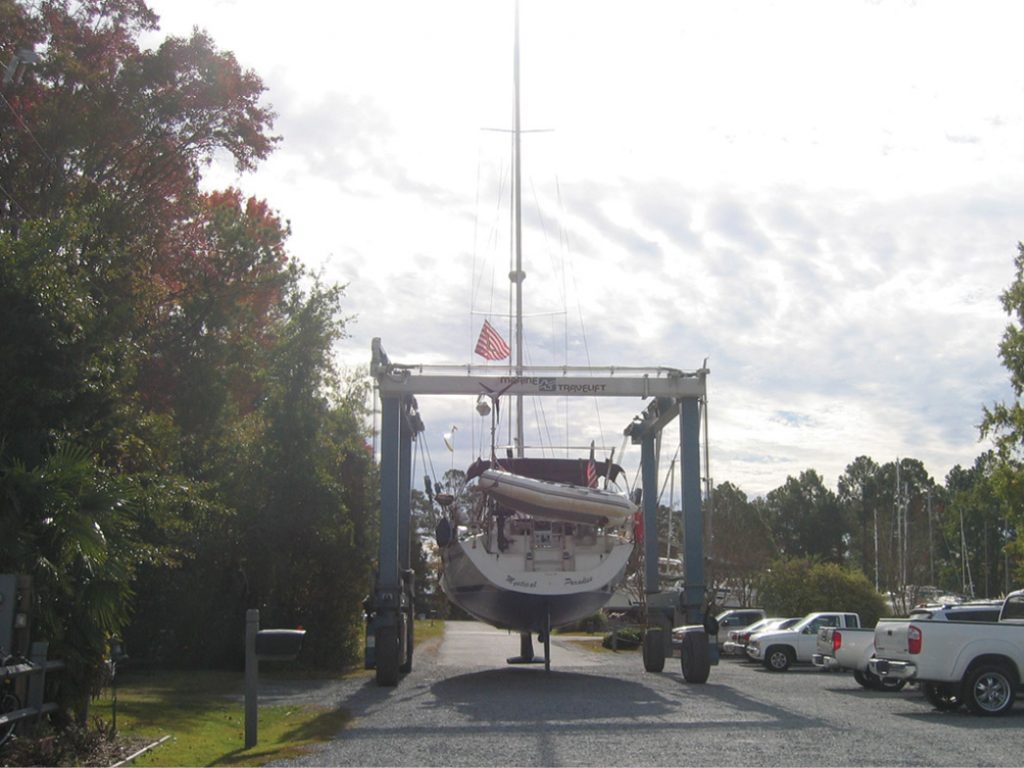
Holding my breath as Mystical Paradise is launched (again!)
Less than two weeks later I got a call from Hinckley telling me the boat was done. This was March 10. If all went well, I could leave Stuart and make Grand Bahama, donate my goods to the people and hospital of Grand Bahama, then sail to the Exumas. There I would do my teaching and training of the park rangers and Defense Force personnel within a couple of days. Afterwards I would still have time for snorkeling and scuba diving in Exumas National Park. My mission was not lost, or so I thought.
I purchased my airline ticket back to Stuart and called Hinckley to assure myself they would be open this weekend so I could pack and provision Mystical Paradise. They assured me they’d be open and could launch me Monday morning and I would be on my way.
Unfortunately, the gods of chance had another surprise. This was the start of the COVID-19 pandemic. Many flights leaving New York were postponed or cancelled. Luckily, I had booked my one-way flight on Frontier Airlines leaving from Islip MacArthur Airport in Ronkonkoma. Two days before departure, the FAA cancelled all flights out of New York. With depression again looming, I called Enterprise Rental and reserved a car. I would drive to Stuart, 1,100 miles away. Barbara thought I was crazy but encouraged me, “Go for it!”
The good thing gods smiled once again, and the next day the FAA cleared flights again. MacArthur was open, and Barb dropped me off Saturday morning. Garbed in gloves, face mask, hat, and protective glasses, no bug would get to me. I boarded the plane and found I was one of ten passengers. It was weird, but I did not complain. I was going.
Arriving at West Palm I rented a car, drove 70 miles to Stuart, and bought provisions. When I returned to Hinckley the gods of chance did it to me once more. Because of the virus and Florida law, Hinckley had closed for the weekend and no one was allowed in the yard until Monday. I found a motel nearby and stayed until Monday.
I arrived at Hinckley bright and early Monday, checked in, and proceeded to the boat. I stored my stuff and was even able to throw on another coat of bottom paint. Around 1:00 pm, the travelift came over ground and deposited Mystical Paradise in the water. The manager of Hinckley and I checked her out with short sea trial. Testing all the gears, I was satisfied she was in good shape. I dropped off the manager and proceeded to a fuel dock, filled up both my water and fuel tanks, and was on my way. Because it was nearly 6:00 pm and getting dark I chose not to exit the unfamiliar inlet, dropping the hook in a local anchorage called Manatee Pocket.
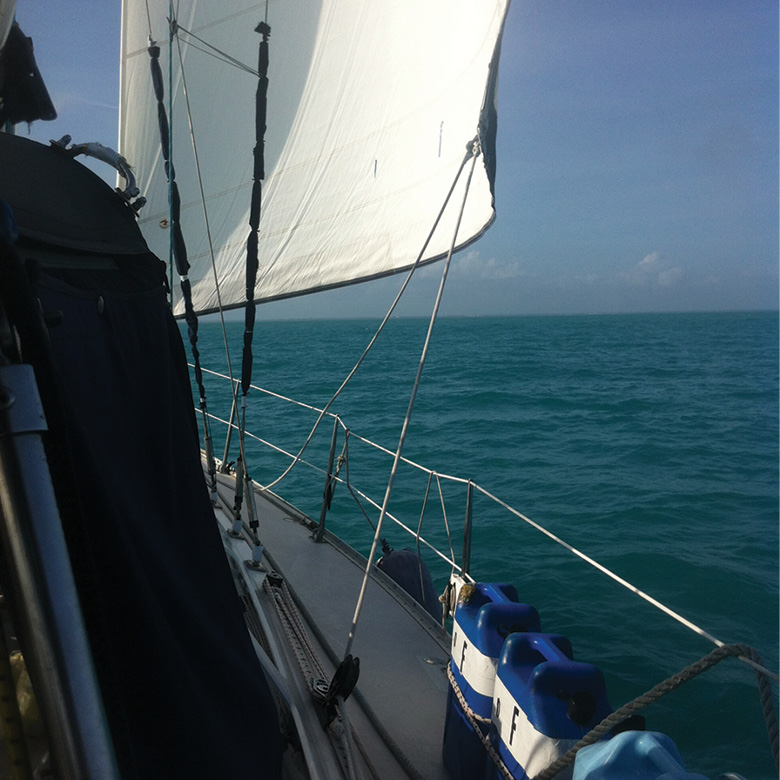
Time at sea provided this trip’s only solace.
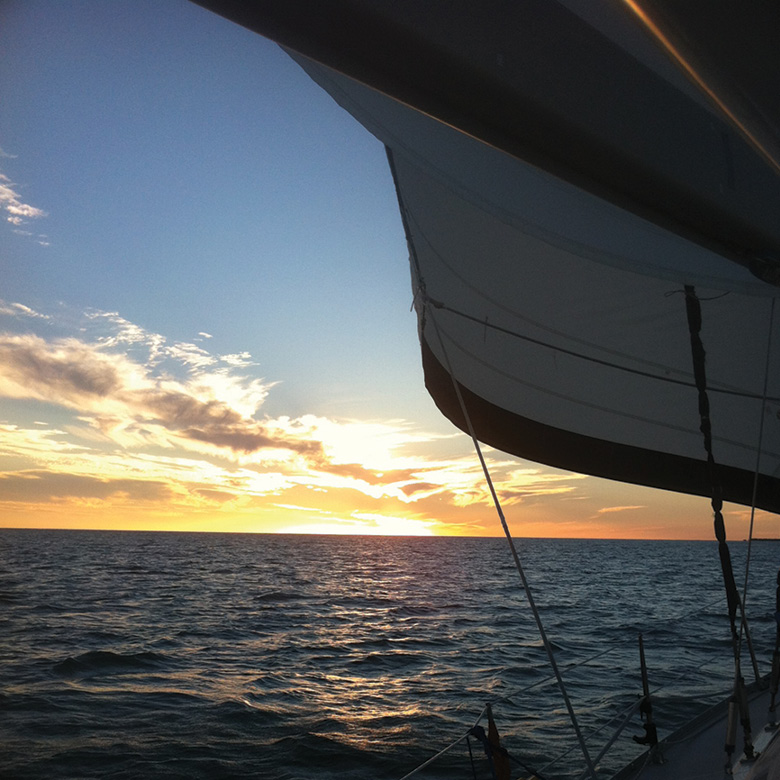
Approaching Jacksonville at sunset
After checking and rechecking all my charts and replaying all of my routes, I slept comfortably knowing I might actually complete my mission. Awakening at 6:00 am, I started the diesel, pulled up the anchor, and slowly motored toward St. Lucie Inlet and the Atlantic for my crossing to Grand Bahama. I noticed an unusual amount of boat traffic heading out with me. Off in the distance I spied a sheriff’s marine boat patrol coming towards me. The boat came alongside and three-gun toting officers questioned my departure and destination points.
I told them of my mission, and plans to go to Grand Bahama and the Exumas for the next month. They advised me the U.S. government had put a quarantine on all boats leaving for The Bahamas. An officer made a phone call and twenty minutes later a Coast Guard patrol boat also came alongside. A Coast Guard officer came aboard my boat and asked for my papers. He too asked for my destination. I repeated my plans, to which he replied I would not be allowed to cross into The Bahamas. The reason was twofold. The U.S. government was forbidding all U.S. citizens to travel to The Bahamas and more importantly, the Bahamian government had closed its borders to all non-Bahamians.
The gods of muck had done it again. My mission was over. I sat there awhile in wonderment and frustration. I asked the Coast Guard if I’d then be allowed to travel north on the Intracoastal Waterway or the ocean to sail home. He replied there were no restrictions to my travel state-to-state, but getting fuel might be a problem as many marinas on the East Coast were shut down. I thanked both officers and told them I would be traveling home.
I motorsailed out of the inlet and made a left-hand turn traveling north. I silently looked to the east and waved goodbye to the islands of the Bahamas as a tear came to my eye. I opened the sails and luckily found the seas only one to two feet and a good westerly wind to carry me homeward. I called Barbara and told her my mission was over. I actually heard relief in her voice as she started crying and wished me well…and to get my ass home. I sailed for forty hours and pulled into Port Canaveral about 11:00 pm the next day. On the way in I counted six large cruise ships anchored outside, awaiting clearance to come in next morning and have the thousands of passengers screened for COVID. I had entered this inlet many times before, and felt comfortable entering in darkness. I proceeded to the last public dock just before the bascule bridge at the west end of Port Canaveral.
Turning south towards the dock, I was facing a stiff outgoing current. It pushed me past the dock twice as I missed the cleats on the dock. This dockage was to be a challenge. I then turned the boat around to face into the current to make docking easier. This third time I was able to catch the front cleat with my bowline. I then jumped onto the dock holding the rear stern line. I started pulling in the stern when suddenly the bowline on the boat let go, sending me uncontrollably backwards. I did a complete reverse tumble-sault into the water.
Luckily, I was wearing my automatic PFD which quickly inflated and brought me to the surface. I looked around for a ladder and found none. The dock was extremely high and I could not pull myself out. It was now 1:00 am and there was no one around. I swam to the end of the dock and fortunately found a half-submerged floating piling. I was in my shorts. I swung my feet onto the piling and immediately felt searing pain on my inner thighs. The hundreds of barnacles on the piling were cutting into my legs. I quickly grabbed the dock and hoisted myself onto it. Shaking like a leaf, I sat there catching my breath and gathering my senses.
I examined the line that had come loose and found the bowline I had tied had come undone. I retied the line and finished securing Mystical Paradise for the night. I went below, took off all my wet clothing, and tended to my wounds. With deep lacerations from the barnacles on the insides of both thighs, I poured myself a stiff drink and was sound asleep by 2:00 am.
I woke early next morning, checked my wounds, poured a cup of coffee, and started the diesel to warm her up. I was still shaking from the night before but wisely had followed my teachings to all my boating class students: Always wear your PFD whether on the boat, on the dock, or near the water. I motorsailed out the inlet about five miles to clear Canaveral Shoals to the north. I slowly turned north opening my sails hoping to enjoy another day of sailing. To my west I saw the giant tower gantries of Cape Canaveral and Kennedy Space Center where NASA and the Air Force have launched so many rockets.
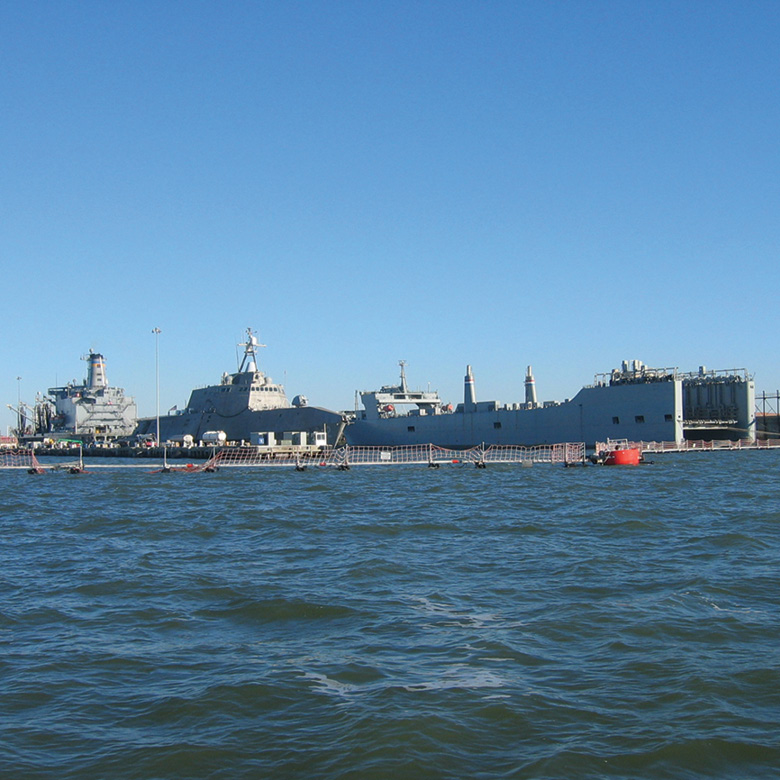
Mayport Naval Base, St. Johns Inlet, Jacksonville
From Cape Canaveral I sailed another two full days and one overnight, and reached St. Johns Inlet to Jacksonville without any issues. I proceeded to the ICW, turned north, and docked at Sister’s Creek Park, a new park with sixty feet of free dockage. I spent a restful night and by early morning was refreshed and ready to leave. Motorsailing north, I noticed many small sportfishing boats trafficking past me at high speeds.
Two miles on, I came across four marine patrol boats, two Florida DEC boats and two local sheriffs’ boats. One DEC boat came alongside, an officer asked for my papers, and inquired as to my departure and destinations. He also asked if I had any perishables on board such as fresh vegetables, fruit, etc. I showed him my papers and replied negative for perishables. While this was happening another ten or twelve small fishing craft zoomed past us at least 30 miles per hour. As the speed limit on the ICW is 5 mph, I was dumbstruck that NONE of the patrol boats even blinked an eye to slow them down. In the nicest non-confrontational voice I could muster, I asked why I was stopped and why all the high-speed traffic was not. The officer on board stated he was performing routine stops on all northbound boats that could possibly be carrying perishables with COVID. As another few fishing craft sped by, I asked if he’d noticed them, to which he did not respond. As a retired law enforcement officer, I stood there in amazement but said
nothing.
I later learned the boats speeding past were going to a fishing tournament just outside Fernandina Beach. Why the cops and the marine patrol boats did not stop any of the boats for exceeding the five mile per hour speed limit on the ICW is a mystery to me, and one I cannot question. Perhaps the officers knew of the need to make the opening gun of the start at the tournament, and were told to overlook anything that impeded the tournament’s opening kickoff. Maybe they knew the open boats couldn’t carry perishables and I could. Perhaps this being Sunday, the rules did not apply.
After my fifth encounter with government marine patrols, I wondered if I had a target on my back. I could not wait to “get outta Dodge.” I planned to motor to Fernandina Beach, exit the ICW at St Mary’s Inlet and get into the ocean. I reached St Mary’s Inlet on the Florida/Georgia border, and there were thousands of the nutsy boaters I’d seen passing me on the ICW. The boats were so thick you could walk across the inlet without ever getting your feet wet. I smiled and thought, “What a waste of gasoline and time on a beautiful Sunday morning.” I zig-zagged my way through the boats, opened my sails, and was soon ghosting along at 2 mph. Winds were light from the south, so I decided to break my rule to start the diesel at less than 3 mph and enjoyed a slow, quiet, but peaceful sail.
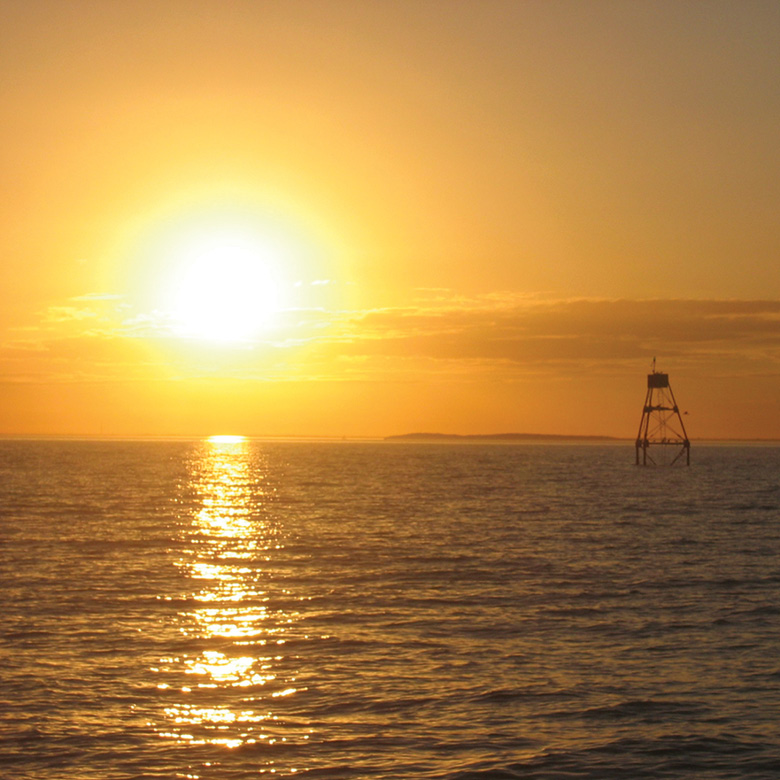
Sunrise at St. Simons Inlet, Brunswick, Georgia
Almost drifting north ever so slowly, I reached St Catherine’s Sound, Georgia and decided to anchor for the night. I also wanted to “test the waters” so to speak to seek availability of fuel on the ICW. I dropped my hook near Kilkenny Marina in Kilkenny, Georgia and slept soundly. Waking at 7:00 am, I called Kilkenny Marina and asked if they were open for fuel. A voice on the VHF radio replied affirmatively, but stated the rules to which I would have to adhere. These included self-docking and pumping my own fuel, something I had done most of my sailing career. I soon pulled into the dock, fueled up and went into the office to pay. I wore a mask and gloves as I was a practicing nurse and was following CDC guidelines. The gentleman in the marina had no mask, no gloves, and no barriers at the counter. I quickly paid the bill and ran out.
Back on my boat, I sprayed my credit card and myself with Lysol to assure I was not carrying COVID. Exiting the marina, I headed for St. Catherine’s Sound via the ICW. I noticed no other northbound cruisers, which was strange for this time of year. Most cruisers head north on the ICW in March through June making for heavy traffic and issues. I did not concern myself, as I needed to get out on the ocean for some peace.
This day the winds were brisk, about 25 mph from the west. I opened my three sails and was soon flying along on a beam reach, hoping no issues would befall me. I sailed for ten hours. Late that day, the winds as usual changed direction clockwise and were now out of the north, hitting me directly on the nose. The waves had also increased from five to eight feet and the ride was becoming extremely uncomfortable. Deciding to go “inside” for a while, I turned into St. Simons Sound and headed towards the ICW. As it was becoming dark, I saw thousands of lights before me in the middle of the inlet, which appeared to be some kind of industrial plant. “What would an industrial plant be doing in the middle of the inlet?” I asked myself. As I got closer I realized it was not a plant but a slew of tugboats and light barges surrounding an overturned freighter.
The freighter, lying on its side, appeared to be some kind of car carrier which had recently flipped over. I later learned it was the Golden Ray Japanese car carrier exiting the Brunswick main Japanese automobile plant. I couldn’t understand how this would happen in relatively shallow waters, but I realized, as always, the ocean and its waters can be treacherous and unforgiving. I continued onto the ICW and made my way to Beaufort, South Carolina. Anchoring for the night I considered how lucky I was, other than the mechanical breakdowns. I had not suffered, didn’t turn over, sink or run aground, and could sail most of the time.
As the NOAA weather station was calling for north winds for the next few days, I stayed inside and motorsailed on the ICW. Reaching Charleston, South Carolina two days later, I anchored across from the beautiful downtown for a much-needed sleep. Next morning, I hoisted anchor and continued to Wrightsville Beach. On the way, passing Southport, North Carolina, I suddenly lost all propulsion. Quickly anchoring just off the waterway, I shut the diesel off and went below to check on the problem.
The driveshaft keyway had come loose and was now lying on the floor. The shaft had come out of the coupling from the transmission and was hanging in the air. I was incredibly lucky to have not lost the driveshaft completely out of the boat. Had that happened, I might have taken on so much water as to sink.
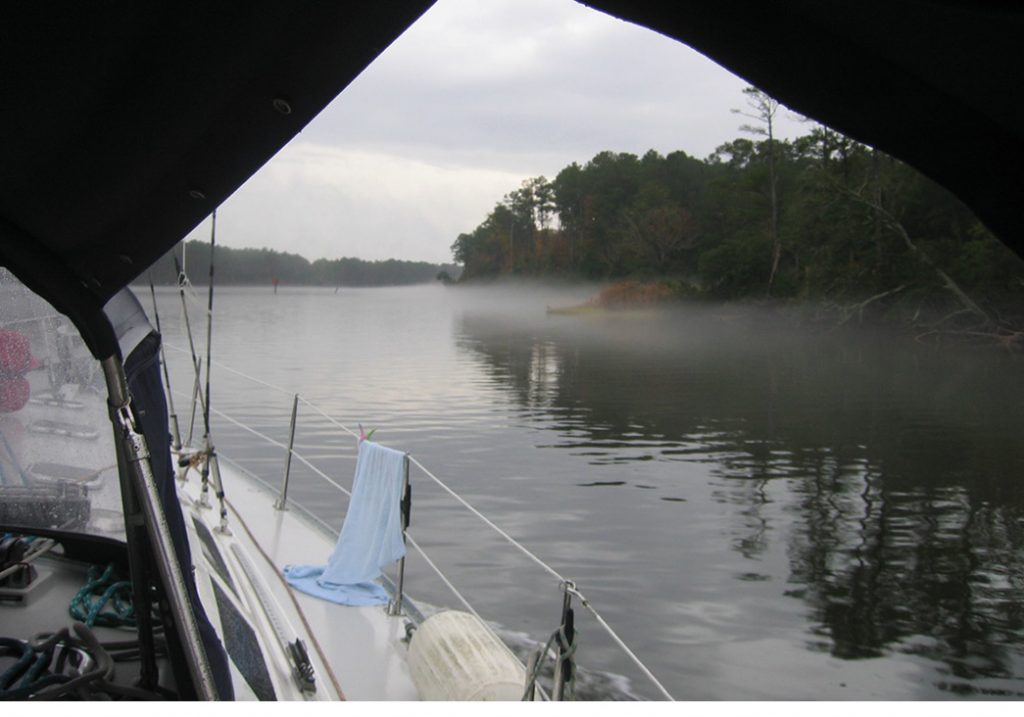
A quiet morning on the ICW
I recovered the keyway, pushed the driveshaft back into the transmission coupling, and jammed the keyway back into place. At this point I felt I could still make Masonboro Inlet at Wrightsville Beach. I anchored just behind Masonboro Inlet. That night the weather channel predicted winds would be light and variable coming from the east, and waves one to two feet. Based on that report, I felt sure I could sail to Beaufort Inlet, North Carolina and motor to Oriental, North Carolina where I would have a marine mechanic repair the damaged keyway. I rechecked my charts and plans to sail the ocean to Beaufort, North Carolina.
Waking next morning to a beautiful sunrise, blue skies and warm temperature, my spirits were elevated. I exited the inlet and, just as the weather channel predicted, I had winds from the east around ten to fifteen. Opening my three sails, I continued my sailing journey north. I sailed the two long days enjoying the invigorating sailing I so loved. Late in the evening of the second day, I saw the lights of Beaufort and, although dark, I knew this inlet and the anchorage just inside next to the Coast Guard station. Anchoring for the night, I felt comfortable that my journey home would continue without mishap.
Next morning, I awoke to another beautiful sunrise as I hauled anchor and motorsailed the forty miles to Oriental. I had taken this route on every trip thus far, as sailing the outside or ocean route from Beaufort Inlet to Norfolk Inlet via the treacherous Hatteras area is both dangerous and stupid. The prudent way to go north or south is inside on the ICW from Beaufort to Norfolk. Arriving in Oriental, I found that the free town down dock was open. About 100 feet from the dock, I lost propulsion once again. There was a large motor cruiser next to me that I did not what to hit. Luckily, the wind gods pushed me to the dock. After securing the boat, I walked to the end of the dock and found yellow police tape across the dock. A large sign stated that all cruisers must self-quarantine on their own boats and not enter the town. I returned to the boat and made phone calls for a mechanic who would do my repairs.
The next day, a mechanic found the keyway had fallen out again and the driveshaft once again had pulled out. Worse, the setscrew on the opposite side on the shaft had not been installed properly when repairs were made back in December at River Forest Boatyard in Bell Haven. He replaced the keyway and properly (but temporarily) reinstalled this setscrew into the driveshaft. He suggested I take the boat to a local boatyard to have repairs done properly before I attempted to motorsail home.
Calling Deaton Boatyard, I was told I’d have to leave the boat unattended for a week to kill any virus, and that repairs would possibly take at least a month or more. She explained a lot of cruisers had left their boats at the yard for repair and it would be a while before they could make repairs on my boat. She also explained I could not stay on the boat but would have to find a local motel. Because there are no local motels in Oriental, and the few bed & breakfasts would be very costly while I waited for my repairs. Deciding to fly home for the third time on this trip, I bought a ticket for a flight home Monday morning from New Bern to JFK.
To be continued…
An avid boater, sailor and scuba diver for over half a century, Anthony Pozun, RN is a sailing instructor and co-chair of the Training Committee at the Northport Yacht Club, an executive officer and senior instructor with the Neptune Sail & Power Squadron, a certified NAUI diver and assistant instructor, a Senior CPR and First Aid instructor with the American Heart Association, and an active New York State Registered Nurse. He’s completed ten solo trips from Long Island to the Bahamas and back aboard Mystical Paradise. Look for a review of Tony’s first book about his journeys, Doing The Ditch, in an upcoming issue of WindCheck.
